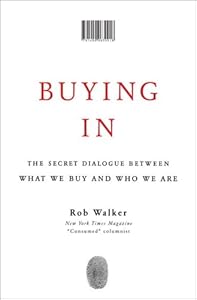I'm still reading Rob Walker's book Buying In: The Secret Dialogue Between What We Buy and Who We Are, and much to my chagrin I only got through another forty pages or so last night.
Walker finally got to the reveal last night: he believes there's nothing special about Red Bull, so all the hype about it (versus other energy drinks) is just that. He says this because it's unique ingredient, supposedly, is taurine, and there's nothing special about taurine. And what's special about Red Bull's marketing? It's unfocused (or defocused) enough for people to project their own meaning onto it.
This, apparently, is the key to the Timberland media strategy too, and how they're able to hold on to their base (blue collar laborers in New England) and reach out to a second demographic group (urban buyers, hip-hop trendies): they admit what Walker calls "projectability," which I suspect means image ambiguity, plus a few cues and clues, not all of which are consistent.
As an aside, I might gently suggest that some of what he's saying regarding projectability could also be said of many religious organizations, but that's another topic for another day.
Walker then tells some anecdotes about BzzAgent and Tremor, organizations that attempt to coordinate and orchestrate word of mouth campaigns; he notes that most of the people who participate in these things do it for the sake of the act itself: they engage in belonging, partly as early adopters and hypesters, but mostly, apparently, for the sense of belonging to something/anything. Walker doesn't delve, because his story isn't about these people, exactly.
Walker revisits some of the Coolhunt territory again, discussing the diffusion of trends through early and late adopter populations. I guess when one stands on Malcolm Gladwell's shoulders it's best to at least namecheck him.
He mentions the strange case of A-Ron, Aaron Bondaroff, a Manhattan scenester who set out to make a living from his lifestyle, and has so far more or less succeeded by promoting clothing among other things, but who mysteriously rejects the "famous for being famous" label; Walker then does the apparently obligatory trudge through sneaker culture and sneakerheads.
Because Walker's story is about the relationship between consumer and brand, and he focuses so tightly on that relationship, he never asks the question I want him to answer: how does all of this work economically? How do the sneaker collectors pay for their dozens to hundreds of pairs of rare Nikes? How do these hypesters and scenesters pay their rent? They can't all just be selling limited-edition Nikes on eBay; the money to buy the sneakers has to some from somewhere. Do they have day jobs? Are they reselling on a secondary market comprised of non-scenesters? Do they all have government grants?
The central message of Buying In seems to be (so far) that to reach postmodern consumers, one has to engage in defocused hype. Or words to that effect.
Sixty pages to go; I may wrap this one up tonight. Watch this space.
Walker's book-related site is Murketing.com.

Walker finally got to the reveal last night: he believes there's nothing special about Red Bull, so all the hype about it (versus other energy drinks) is just that. He says this because it's unique ingredient, supposedly, is taurine, and there's nothing special about taurine. And what's special about Red Bull's marketing? It's unfocused (or defocused) enough for people to project their own meaning onto it.
This, apparently, is the key to the Timberland media strategy too, and how they're able to hold on to their base (blue collar laborers in New England) and reach out to a second demographic group (urban buyers, hip-hop trendies): they admit what Walker calls "projectability," which I suspect means image ambiguity, plus a few cues and clues, not all of which are consistent.
As an aside, I might gently suggest that some of what he's saying regarding projectability could also be said of many religious organizations, but that's another topic for another day.
Walker then tells some anecdotes about BzzAgent and Tremor, organizations that attempt to coordinate and orchestrate word of mouth campaigns; he notes that most of the people who participate in these things do it for the sake of the act itself: they engage in belonging, partly as early adopters and hypesters, but mostly, apparently, for the sense of belonging to something/anything. Walker doesn't delve, because his story isn't about these people, exactly.
Walker revisits some of the Coolhunt territory again, discussing the diffusion of trends through early and late adopter populations. I guess when one stands on Malcolm Gladwell's shoulders it's best to at least namecheck him.
He mentions the strange case of A-Ron, Aaron Bondaroff, a Manhattan scenester who set out to make a living from his lifestyle, and has so far more or less succeeded by promoting clothing among other things, but who mysteriously rejects the "famous for being famous" label; Walker then does the apparently obligatory trudge through sneaker culture and sneakerheads.
Because Walker's story is about the relationship between consumer and brand, and he focuses so tightly on that relationship, he never asks the question I want him to answer: how does all of this work economically? How do the sneaker collectors pay for their dozens to hundreds of pairs of rare Nikes? How do these hypesters and scenesters pay their rent? They can't all just be selling limited-edition Nikes on eBay; the money to buy the sneakers has to some from somewhere. Do they have day jobs? Are they reselling on a secondary market comprised of non-scenesters? Do they all have government grants?
The central message of Buying In seems to be (so far) that to reach postmodern consumers, one has to engage in defocused hype. Or words to that effect.
Sixty pages to go; I may wrap this one up tonight. Watch this space.
Walker's book-related site is Murketing.com.


![Reblog this post [with Zemanta]](http://img.zemanta.com/reblog_e.png?x-id=aa4b02d1-09b3-47c1-8fb0-abd3068073e6)

No comments:
Post a Comment